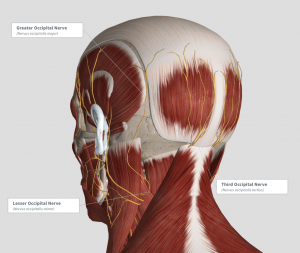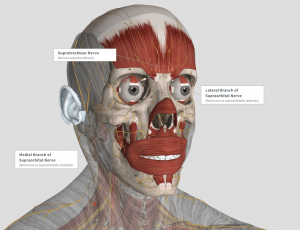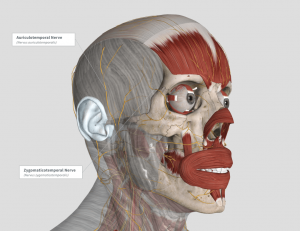
The Anatomy of a Headache
Nerve Compression Headaches
After some of his brow lift patients reported an improvement in headaches, Dr. Bahman Guyuron began to investigate the effect of nerve compression as a factor in migraine headaches. It was then that Dr. Guyuron’s work started the field of surgical nerve decompression for the treatment of migraine headaches.
As the nerves above the orbits, also known as the eye sockets, were decompressed from the release of tissue during a brow lift, other constricted nerves were identified as sources of migraine headaches. Following this discovery, surgical approaches to decompress these nerves were developed, and the honing of these techniques has provided migraine relief for thousands of patients. The nerves that can be addressed in the surgical treatment of migraine headaches include:

- The supra-orbital and supra-trochlear nerves above the eye socket
- The zygomaticotemporal and auriculotemporal nerves in the temple region
- The greater and third occipital nerves at the base of the back of the head and the lesser occipital nerves in the lateral aspect of the back of the neck
- The nerves supplying the lining of the nose
Each of these nerves has been identified as a trigger point for migraine headaches. When constricted by surrounding tissue, these nerves become irritated and begin what patients recognize as headache-producing pain and other migraine symptoms. Several things can cause constriction of these nerves.
In the area above the eye socket, the corrugator muscles can push on the supra-orbital and supra-trochlear nerves, creating irritation. At the base of the skull and upper neck, everyday tension and stress can cause the trapezius muscles to tighten around the occipital nerves, causing severe headache symptoms.
Connective tissue bands around the nerves in the back of the neck are another cause of constriction that can irritate the occipital nerves, resulting in headaches and migraines. Swelling of the nasal lining can cause compression of the nerves of the nose against other parts of the nasal passage, irritating these small nerve endings and triggering headaches that seem to arise in the sinus region of the midface.
Some people are born with small notches in the bone above the eye, called the superior orbit, where the supraorbital and supratrochlear nerves can pass without tension. Other patients have bony tunnels instead of notches, which can be too small for the nerves to pass through comfortably and can cause compression and irritation in these areas.
Any of these nerves can be constricted by blood vessels, though the most susceptible to this type of irritation are the three occipital nerves and the two nerves found in the temples. Because it is often an artery next to the nerve causing the irritation, patients may experience a “pulsating headache” associated with nerve irritation caused by nearby blood vessels.
Central Headaches
Central headaches are headaches that are caused by a dysfunction of the chemistry or anatomy of the brain. Because the skull is a hard and fixed encasement for the brain, any tissue swelling within the skull can cause pain. For example, the dilation of blood vessels within the skull or the growth of a lesion may increase the pressure on the brain and cause headaches.
Other central headaches are thought to occur due to fluctuations in chemical mediators, such as serotonin, which can also have profound effects on mood and personality. For the most part, headaches originating from a central source inside the skull are not responsive to the type of migraine headache surgery we offer at Migraine Surgery Specialty Center and require evaluation by a neurosurgeon.
How Does Migraine Headache Surgery Address These Issues?
By surgically releasing constricted nerves from the surrounding tissue, the nerves are allowed to conduct their business without the irritation that causes the symptoms of migraine headaches. The success of migraine surgery is defined as the complete elimination of migraine symptoms or more than a 50% decrease in the symptoms associated with migration headaches. Migraine surgery through the surgical release of the nerves listed above has a success rate of approximately 90%. Roughly 45% of patients who have migraine surgery report complete resolution of their headache pain and associated symptoms, while the remaining 45% of patients report life-changing though incomplete improvement, requiring less medication, less time away from family and work, and a return to a normal lifestyle.



